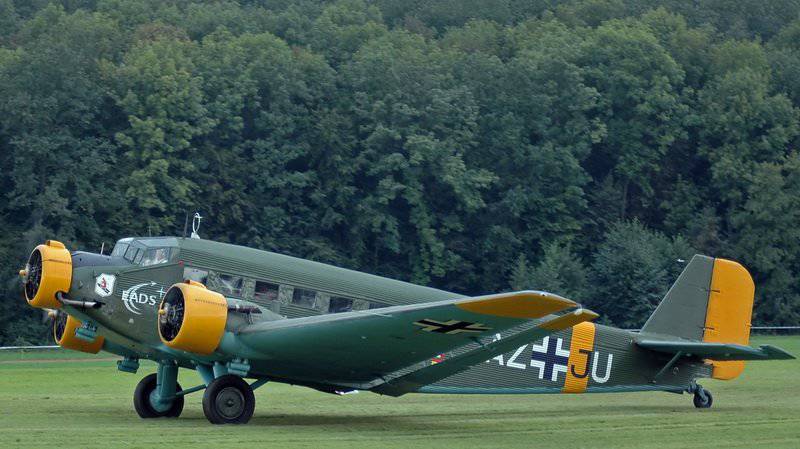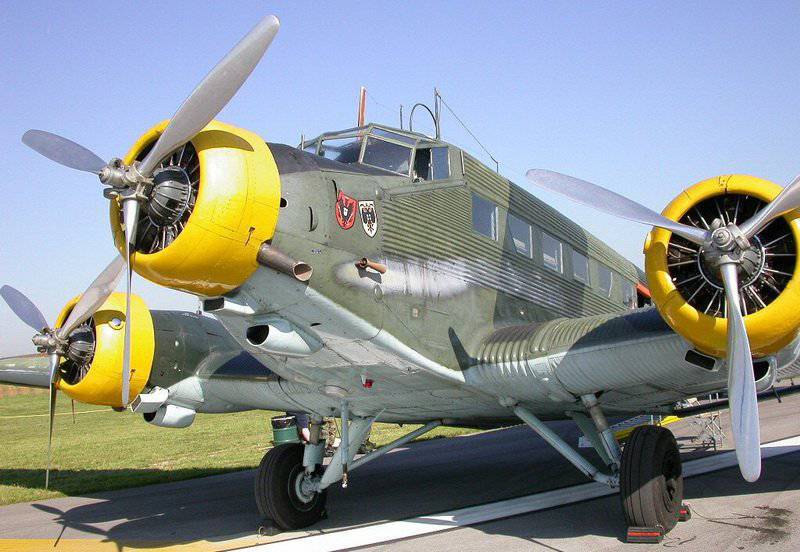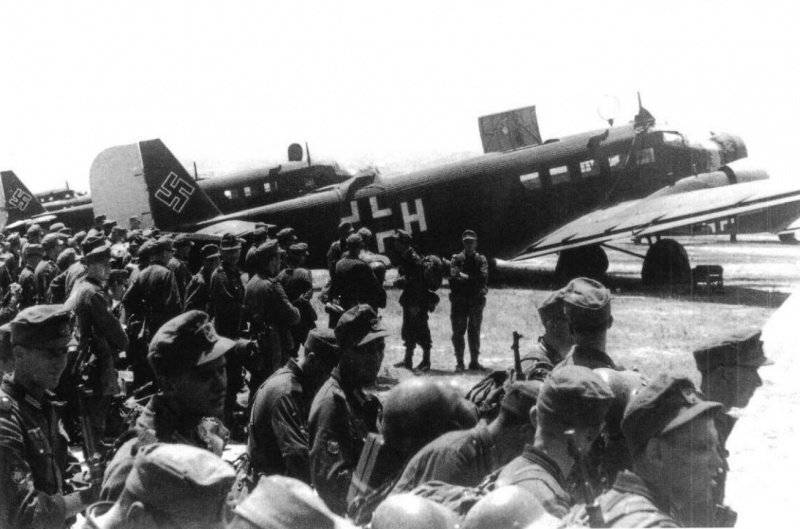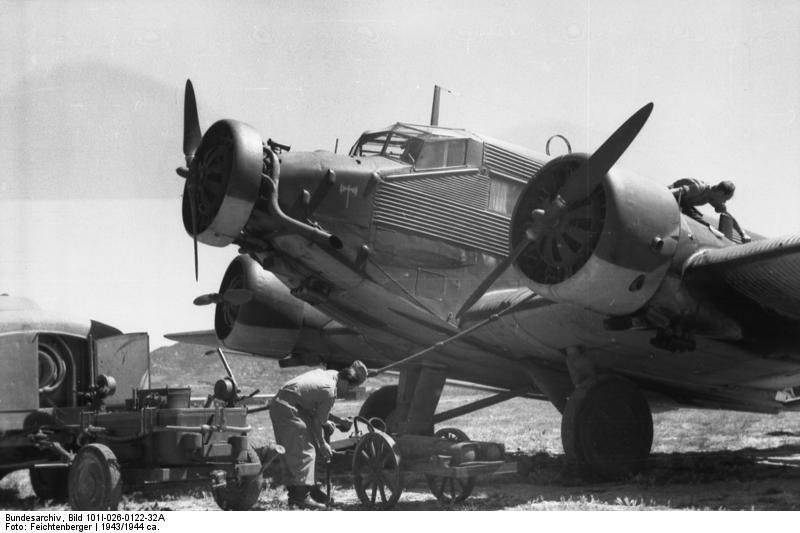Ju-52 - Luftwaffe Workhorse
The development of the transport plane Ju.52 in the Junkers design bureau began in 1929, the creation of the aircraft was headed by E. Tsindel. The main requirements for the new aircraft were its simplicity, low cost of operation and reliability. Ceiling and airspeed was of secondary importance. The draft single-engine version of the Ju.52 was ready by the end of the 1929 of the year. A feature of the project was that without any special constructive alterations the aircraft could be equipped with 3 engines. The first prototype of a single-engine aircraft manufactured in the transport version was ready by the end of September 1930. Ju.52 for the first time rose the air of October 13 1930. In February 1931, the aircraft was demonstrated to the general public at the Berlin Tempelhof Airport.
In June, 1931, the aircraft underwent pilot operation at Lufthansa Airlines. During the tests and trial operation, changes were made to the design of the aircraft: the wing was strengthened, the airframe was modified, the engines were replaced. At the same time, work was under way to prepare for the serial production of the aircraft. The first serial Ju.52 / 3m (three-engine) first flew in April 1931. The following year, deliveries of cars to commercial airlines began, and in the fall of 1933, the Junkers company began the production of a military version of the Ju.52 / 3m aircraft.

Ju.52 production continued in Germany until the end of 1944. In addition to Germany, the aircraft were manufactured in France at the Amiot enterprise, a number of cars were assembled in Hungary and Romania from car kits supplied from Germany. In total, about 4850 Ju.52 aircraft of various modifications were produced. The civilian version of the machine was widely exported, while only Portugal (10 aircraft), Austria (4 aircraft) and Switzerland (3 aircraft) purchased the military version. In the mid-1930s, Ju.52 aircraft accounted for 2/3 of the total bomber aviation Luftwaffe.
After Adolf Hitler came to power in 1933, Germany began creating its own air force. First of all, the military turned their attention to Ju-52 / Зm. This aircraft, which possesses reliability, a large payload and a speed sufficient for those times already in 1934, was presented in a bomber modification. Conversion of the civilian version of Ju.52 / 3m into a bomber was quite simple.
On top of the plane was mounted an open turret with one MG-15 machine gun (1050 ammunition ammunition). To protect against attacks from the lower plane, there was a semi-detachable “basket” with the second MG-15 machine gun (750 ammunition of cartridges). This "basket" was produced and cleaned manually. It was attached to the semi-glazed cab - the place of the scorer, which was located between the bomb bay - 2-me front and rear. Each of the bomb bay could hold a DSAC / 250 cassette containing 10 50-kg SC-50 bombs or 2 250-kg SC-250 bombs. The maximum bomb load of the machine was 1500 kg. The fuel supply was 2475 liters, which was quite enough to ensure a tactical range of 500 km when driving at a cruising speed of 245 km / h. At the same time, the plane was easily reworked back to the transport version. Modifications are also known, on which an 13-mm machine gun was mounted on the upper turret and another 2-machine gun of the 7,92-mm caliber was mounted in the windows of the cargo compartment (one for each side).

Together with the Do-17 and Ju-86 bomber converted from passenger and transport aircraft, the Ju-52 / 3m was used during the Spanish Civil War as part of the German air legion Condor. By the end of the war, they had raided 13 000 hours and dropped more than 6 000 tons of bombs to Republican positions. As the modern bombers of the Luftwaffe entered into service, the Ju-52 / Зm aircraft were gradually transferred from bomber to transport squadrons and soon began to be used for their intended purpose, being used for landing and transportation of troops and cargo. Equipped as a standard military transport aircraft, the Ju-52 / Зm had the following design.
The wide fuselage of the aircraft had a rectangular cross-section and was rounded at the top. The fuselage was made from the usual for the company "Junkers" materials - corrugated sheet duralumin, metal pipes and profiles. For the convenience of transporting the aircraft fuselage could be disassembled into 3 parts. The pilot's cabin had a large glass area and was quite spacious, which was achieved due to the large removal of the middle engine, which was located in the nose of the car. The review from it was very good. Pilots' seats were located nearby, Ju-52 / 3m had dual controls. Behind the pilots' backs was the radio operator's seat. Most of the fuselage was occupied by a passenger / cargo cabin with a total volume of 19,6 cubic meters. meters Fully armed 18 soldiers could be placed in the cockpit, 13 wounded on stretchers + 1, an attendant or attendant, as well as the corresponding cargo.
The trapezoidal wing of the aircraft was composed of a small center section and 2-x consoles, the landing gear leaned on the center section. Unlike previous models of Junkers passenger aircraft, the flanks of the side members were arranged in pairs on the same vertical and formed the 4 side members made of duralumin tubes with diagonal duralumin walls. The wing skin, as well as the entire aircraft fuselage, was made of corrugated duralumin sheet.
The tail of the machine was all-Ural single-chin. The horizontal tail of the 52 / 3m had a large elongation and therefore, in order to avoid vibrations, it was reinforced at the front edge with a pair of struts. The aircraft was equipped with a three-post landing gear that could not be removed during the flight. The main pillars were of the pyramidal type and were supplied with an additional rigid brace that worked under tension when the brakes were applied. The chassis of the car had a hydropneumatic shock absorption, usually the wheels were covered with special fairing, which improved the aerodynamic characteristics of the aircraft. The possibility of installation instead of the wheels of the float system was also provided.

The power plant of the transport aircraft included 3 nine-cylinder radial BMW-132 engines of various modifications. The side engines were equipped with NACA hoods, and the average engine had a Townend ring, which, to a lesser extent compared to NACA hoods, impaired visibility from the cockpit. In order to improve the action of the rudders (especially if the middle engine stops), as well as reducing the turning moment in case of a side engine stop, the side motors were mounted at an angle to the longitudinal axis of the aircraft.
Aircraft Ju-52 / 3m should be considered the real "workhorse" of the Luftwaffe, they were reliable and unpretentious. After a rather short use in the role of bombers, they regularly transported cargoes and troops, were used to tow gliders and to search for sea mines. We played a very important role in the largest airborne operations conducted by Germany. At the same time, transport squadrons of the Luftwaffe sometimes suffered losses that were quite comparable with the losses of combat squadrons. So, only during the landing operation “Mercury” on the island of Crete from 493 of the Ju-52 / 3m planes involved in it, the Germans lost 174 machines. In turn, during the supply by air of the 6 of the German field army encircled in Stalingrad, part of the Luftwaffe transport squadrons was almost completely destroyed.

It is worth noting that despite its rather archaic design, the aircraft has proven itself to be very simple and reliable in operation. There is a case when 16 February 1937, one Ju.52 / 3m, withstood 24 attacks from the Republican I-15 fighters and only after that was shot down. The Ju.52 / 3m was easy to maintain and manage. Reliable chassis of the machine and its low landing speed allowed to operate the aircraft not only from concrete airfields, but also from ground. Along with fairly clear advantages, which included high manufacturability and structural strength, good handling and stability in the air, the ability to use from field airfields, the Ju-52 / 3m had equally obvious disadvantages - low flight speed (due to non-retractable landing gear and corrugated plating), as well as the impossibility of transporting bulky cargo and small military equipment. Despite this, the Ju.52 / 3m was used on all fronts of World War II as long as it was possible.
Performance characteristics of the Ju.52 / 3m:
Dimensions: wingspan - 29,3 m, length - 18,9 m, height - 5,55 m
Wing area - 110,0 square. m
The weight of the aircraft, kg
- empty - 6 500
- normal takeoff - 10 500
- maximum take-off - 11 000
Engine type - 3 nine-cylinder engine BMW-132 horsepower 285 hp each
Maximum speed - 250 km / h
Practical range, km
- normal - 1090
- with additional tanks - 13 000
Maximum rate of climb –175 m / min
Practical ceiling - 5 900 m
Crew - 2-3 person.
Payload: 1500 kg. cargo or bombs, or 18 passengers.
Armament: 1 7.92-mm machine gun MG-15 or 13-mm MG-131 on the upper turret, 2 MG-15 in the side windows. Up to 30 50kg bombs or 6 250-kg bombs in 3's bombs.
Sources used:
www.airwar.ru/enc/cww2/ju52.html#LTH
www.airpages.ru/lw/ju52bp.shtml
www.aeroram.narod.ru/win/samolet/ju-52.htm
www.aviacija.dljavseh.ru/Samolety/Junkers_Ju_52.html
Information